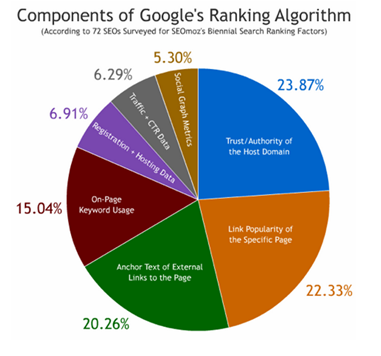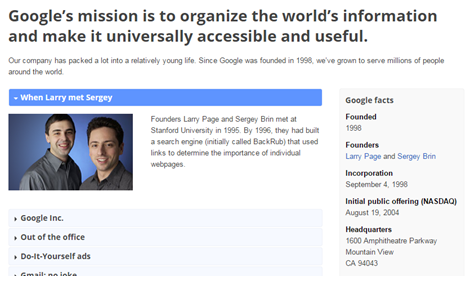
When people talk about SEO, what immediately comes to mind are the humongous effort thrown around to build links – lots and lots of links. Do you know that as much as 37% of businesses with a strong online presence spend anywhere between $10K and $50K a month just to build quality links? This is just an indication of how important link building is as a ranking factor and how it can boost your brand’s online presence.
But link building isn’t what it used to be.
In an era where Penguins crack down on low quality links and Pandas mow down spammy links and any other links that were intended to manipulate Google’s rankings in many ways, the key to link-building success is to generate natural quality links. However, it is not as simple as it used to be.
So, how can you generate the right kind of links for your site?
It’s all about trust and popularity and on how you can make your hosted domain a trusted and authoritative source of online information. This is so important that Copyblogger reported domain trust and authority as the primary component of Google’s ranking algorithm at 23.87%.

When the online community trusts or considers your site an authority, you create a good user experience, which will soon generate natural links – and this bodes well for your ranking at Google’s search result pages. The following describes 8 strategic steps on how you can build such quality links the natural way.
1. Understand the Likes, Desires and Needs of your Target Audiences
Link building from a post-Penguin, post-Panda perspective goes beyond mere propagation of backlinks from whatever resources or channels available online. Building natural and quality links stems from you providing what your target audiences’ likes, desires, and needs.
Google rewards sites that gives value to their targeted audiences, and giving value means providing exactly what your targeted audiences were specifically requiring or intending when they made the search. This will require extensive opportunity assessment and comprehensive market research.
In today’s SEO landscape, this is called satisfying user or audience intent.
2. Focus on Your Content
Once you’ve identified the intent of your targeted audiences when they make their search queries, you can then focus and streamline your content with your audiences’ intent in mind. Here are some of the main characteristics your streamlined content should have.
a. It Should be Supported by Data
Your content should be data-rich and well-supported with facts to make it a valuable source of information that your targeted audiences can cite or link to during their online engagements. Such types of content include:
- Resource Guides
- How-Tos
- Curated Lists
- Reference Materials
- Educational Articles
- Infographics
- Polls And Surveys
b. It Should Appeal to their Emotions
Content that triggers your targeted audiences’ emotions will surely generate engagement, social votes and natural links. Examples of such content include:
- Entertainment-Focused Articles
- Industry Expert Polls and Awards
- Humorous Material (e-Cards, satire, etc)
- Pre-Reciprocation
- Expert Interviews and Analysis
- Charity-Event Promotion
- Scholarships
- Cause-Related Marketing Promotions
c. It Should Provide a Solution to their Problems
Content that generates natural links are those that are specifically designed to provide a comprehensive solution to a particular problem. These types of content can also include utilitarian online or downloadable tools such as calculators, currency converters, widgets and apps.
3. Get Your Content Well Organized

Google has always been the primary target platform for SEO and link-building, so it is but practical to focus and align your marketing efforts to Google’s own mission and strategy, which you can clearly see from their website – to organize information.
This is part of Google’s philosophy so it would do your online presence real good if you align your content with such philosophies. In line with this, your content should also be well-organized as well as provide useful information that are valuable enough to make other sites and users link to yours.
Neil Patel provides some good examples. In his article “How to Build High Quality Backlinks in a Scalable Way”, he showed the following website image as one with a good navigational structure.

Neil then showed the following website capture as an example of a site with poor navigational structure.
 According to Neil, getting your navigational structure optimized will make it more relevant and useful. It will also make it easier for online users as well as the search engines themselves to find and index your content.
According to Neil, getting your navigational structure optimized will make it more relevant and useful. It will also make it easier for online users as well as the search engines themselves to find and index your content.
4. Diversify Your Links
Natural and quality links should not always be pointed exclusively to your homepage only. On top of that, you should also have a good internal link structure that are well-balance with external links that point to influencers and other relevant sites. It would also be a good practice to get backlinks not only from sites with the .com extension, but from other types of websites as well, particularly those that have the .org, .net, .gov, and .edu extensions.
5. Leverage on Social Media for Link Building
Social media is a perfect channel for promoting your content as it enables your site to reach out to a wider audience, generate engagement, social votes, and natural links. When using social media for link building, you should focus on creating and providing content that are appealing to the users of the particular social network you are marketing to. Create a good balance between self-promotion and providing content of value such as data-rich posts, infographics, and image-backed articles. Videos, used by as much as 87% of agency marketers, is a great way of promoting highly shareable content that generates natural links.
6. Boost Your Online Network
Unlike traditional link building, building natural and quality links involve boosting your own online network. It’s about building a community that reciprocates links, engages with your content, creating more brand exposure. Strategies in line with this include:
Engaging with Influencers
Aside from reaching out to targeted audiences, you should also try to build a network that includes industry influencers. Create links to them in a bid to generate engagement, and soon a relationship that you should nurture in order to get precious backlinks coming your way
Think PR
Natural and quality link building goes beyond mere SEO. It’s now all about harnessing digital marketing as a complete PR platform, reaching out to journalists, editors, and other industry influencers in a bid to make them see your content as worthy for their own use. The key here is to create content that offers great value to yours – and theirs – targeted audiences.
Establish Yourself as an Expert
Who do people listen to? Experts. That’s one critical mindset you should have when building natural links. People online just don’t listen to anyone, no matter how loud or boisterous their campaigns are. People listen to experts, and in order for people to listen to you – you should become an expert yourself. You can do this by creating and providing data-rich and well-research articles, infographics, eBooks and other similar materials backed with user engagements
Give Something Away
People online love joining contests, participate in special offers and line up for giveaways. So, it is but natural to leverage of these channels and create your own giveaways and promotions that you can run through social media, your website, or other people’s blogs
7. Clean Your Backyard
When shifting from a traditional to a natural link-building program, you should remember to clean up your own backyard too and remove traces of old links that can be detrimental to your own natural link building efforts. Check out this comprehensive guide from Cognitive SEO (disclaimer: this is the internal tool we are using for detecting and cleaning bad links).
This involves tracing your backlinks and removing those that can be identified as spammy. In a similar manner, links from good sources but are no longer active can be revived or reclaimed so you can get greater value from them.
Lastly, you should also maintain and monitor your link network – and be ready for anything Google throws your way in the future.
8. Publish Your Content Externally
Building natural and quality links involves the publication of your content not only through your own websites and channels, but through external publishing channels as well. Such channels include:
- Press release platforms
- Business Listings and Social Profiles
- Topical Content Hubs
- User Rating Review Sites
- Infographic submission sites
- RSS directories
- Topical and Authoritative Guest Posting
Resource: Neil Patel of Quick Sprout offered a very cool guide from his own experience doing guest post marketing.
The online community is changing and search engines strive to give value to this community by optimizing their search algorithms and providing search results that are more relevant and closer to the intent of the search user. In line with this, the focus in link-building has likewise shifted towards natural links. Digital marketers should retrace their steps, check their own link networks and start building a new link network that is natural and organic – just like how Google wants it!
Jomer B. Gregorio is a well-rounded expert when it comes digital marketing. Jomer is also known as a semantic SEO evangelist and practitioner. Check out our Digital Marketing Services today and let us help you in achieving positive and profitable results for your business.
